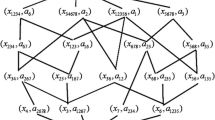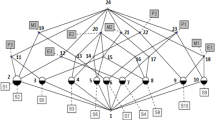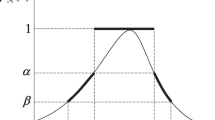Abstract
As an important tool for data analysis and knowledge processing, formal concept analysis has been applied to many fields. In this paper, we introduce a decomposition method of a formal context to construct its corresponding concept lattice, which answers an open problem to some extent that how this decomposition method of a context translates into a decomposition method of its corresponding concept lattice. Firstly, based on subcontext, closed relation and pairwise noninclusion covering on the attribute set, we obtain the decomposition theory of a formal context, and then we provide the method and algorithm of constructing the corresponding concept lattice by using this decomposition theory. Moreover, we consider the similar decomposition theory and method of a formal context from the object set. Finally, we make another decomposition of a formal context by combining the above two results.






















Similar content being viewed by others
Explore related subjects
Discover the latest articles, news and stories from top researchers in related subjects.References
Wang XZ, Xing HJ et al (2015) A study on relationship between generalization abilities and fuzziness of base classifiers in ensemble learning. IEEE Trans Fuzzy Syst 23(5):1638–1654
Wang XZ, Ashfaq RAR, Fu AM (2015) Fuzziness based sample categorization for classifier performance improvement. J Intell Fuzzy Syst 29(3):1185–1196
Ashfaq RAR., Wang XZ et al (2016) Fuzziness based semi-supervised learning approach for intrusion detection system. Inf Sci. doi:10.1016/j.ins.2016.04.019
Ashfaq RAR, He YL, Chen DG (2016) Toward an efficient fuzziness based instance selection methodology for intrusion detection system. Int J Mach Learn Cybern. doi:10.1007/s13042-016-0557-4
Wille R (1982) Restructuring lattice theory: an approach based on hierarchies of concepts. In: Rival I (ed) Ordered sets. Reidel, Dordrecht-Boston, pp 445–470
Ganter B, Wille R (1999) Formal concept analysis: mathematical foundations. Springer-Verlag, Berlin
Davey BA, Priestley HA (2002) Introduction to lattices and order. Cambridge University Press, Cambridge
Poelmans J, Ignatov DI, Kuznetsov SO, Dedene G (2013) Formal concept analysis in knowledge processing: a survey on applications. Expert systems with applications 40(16):6538–6560
Kaytoue M, Kuznetsov SO, Napoli A, Duplessis S (2011) Mining gene expression data with pattern structures in formal concept analysis. Inf Sci 181(10):1989–2001
Codocedo V, Napoli A (2015) Formal concept analysis and information retrieval-a survey. ICFCA 9113:61–77
Wang XZ (2015) Learning from big data with uncertainty-editorial[J]. J Intell Fuzzy Syst 28(5):2329–2330
Tonella P (2003) Using a concept lattice of decomposition slices for program understanding and impact analysis. IEEE Trans Softw Eng 29:495–509
Ganapathy V, King D, Jaeger T, Jha S (2007) Mining security sensitive operations in legacy code using concept analysis. In: Proc. 29th Int. conference on software engineering, pp 458–467
Bělohlávek R, Sigmund E, Zacpal J (2011) Evaluation of IPAQ questionnaires supported by formal concept analysis. Inf Sci 181(10):1774–1786
Singh PK, Kumar CA, Gani A (2016) A comprehensive survey on formal concept analysis, its research trends and applications. Int J Appl Math Comput Sci 26(2):495–516
Wu WZ, Leung Y, Mi JS (2009) Granular computing and knowledge reduction in formal contexts. IEEE Trans Knowl Data Eng 21(10):1461–1474
Wei L (2005) Reduction theory and approach to rough set and concept lattice. Xi’an Jiaotong University, Xi’an
Shao MW, Leung Y (2014) Relations between granular reduct and dominance reduct in formal contexts. Knowl Based Syst 65:1–11
Dias SM, Vieira NJ (2015) Concept lattices reduction: defnition, analysis and classifcation. Expert Syst Appl 42:7084–7097
Mi JS, Leung Y, Wu WZ (2010) Approaches to attribute reduction in concept lattices induced by axialities. Knowl Based Syst 23:504–511
Ishigure H, Mutoh A, Matsui T, Inuzuka N (2015) Concept lattice reduction using attribute inference. In: IEEE 4th global conference on consumer electronics, Osaka, Japan, pp 108–111
Kumar CA, Dias SM, Vieira NJ (2015) Knowledge reduction in formal contexts using non-negative matrix factorization. Math Comput Simul 109:46–63
Shao MW, Leung Y, Wu WZ (2014) Rule acquisition and complexity reduction in formal decision contexts. Int J Approx Reason 55:259–274
Li JH, Mei CL, Lv YJ (2013) Incomplete decision contexts: approximate concept construction, rule acquisition and knowledge reduction. Int J Approx Reason 54(1):149–165
Kumar CA, Srinivas S (2010) Mining associations in healthcare data using formal concept analysis and singular value decomposition. Biol Syst 18(4):787–807
Kumar CA (2012) Fuzzy clustering based formal concept analysis for association rules mining. Appl Artif Intell 26(3):274–301
Wang LD, Liu XD (2008) Concept analysis via rough set and AFS algebra. Inf Sci 178:4125–4137
Wan Q, Wei L (2015) Approximate concepts acquisition based on formal contexts. Knowl Based Syst 75:78–86
Singh PK, Kumar ChA, Li JH (2015) Concepts reduction in formal concept analysis with fuzzy setting using Shannon entropy. Int J Mach Learn Cybern 6(1):1–11
Bělohlávek R (2000) Similarity relations in concept lattices. Logic Comput 10:823–845
Yao YY (2008) Probabilistic rough set approximations. Int J Approx Reason 49:255–271
Xu WH, Li WT (2016) Granular computing approach to two way learning based on formal concept analysis in fuzzy datasets. IEEE Trans Cybern 46(2):366–379
Li JH, Mei CL, Xu WH, Qian YH (2015) Concept learning via granular computing: a cognitive viewpoint. Inf Sci 298:447–467
Li JH, Ren Y, Mei CL, Qian YH, Yang XB (2016) A comparative study of multigranulation rough sets and concept lattices via rule acquisition. Knowl Based Syst 91:152–164
Li KW, Shao MW, Wu WZ (2016) A data reduction method in formal fuzzy contexts. Int J Mach Learn Cybern. doi:10.1007/s13042-015-0485-8
Li MZ, Wang GY (2015) Knowledge reduction in crisply generated fuzzy concept lattices. Fundam Inf 142(1–4):307–335
Cornejo ME, Medina J, Eloisa R (2015) Cuts or thresholds, what is the best reduction method in fuzzy formal concept analysis? Fuzzy Systems (FUZZ-IEEE). In: 2015 IEEE international conference on Istanbul. doi:10.1109/FUZZ-IEEE.2015.7337990
Yao YY (2016) Rough-set concept analysis: interpreting RS-definable concepts based on ideas from formal concept analysis. Inf Sci 346–347:442–462
Zhi HL, Li JH (2016) Granule description based on formal concept analysis. Knowl Based Syst 104:62–73
Li JH, Huang CC, Qi JJ, Qian YH, Liu WQ (2016) Three-way cognitive concept learning via multi-granularity. Inf Sci. doi:10.1016/j.ins.2016.04.051
Yao YY (2012) An outline of a theory of three-way decisions. Rough Set and Knowledge Technology, Spring International Publishing: volume 7413 of Lecture Notes in Computer Science, pp 1–17
Qi JJ, Wei L, Yao YY (2014) Three-way formal concept analysis. rough set and knowledge technology. In: Lecture notes in computer science, vol 8818. Spring International Publishing, pp 732–741
Bělohlávek R, Vychodil V (2010) Discovery of optimal factors in binary data via a novel method of matrix decomposition. J Comput Syst Sci 76:3–20
Outrata J, Vychodil V (2012) Fast algorithm for computing fixpoints of Galois connections induced by object-attribute relational data. Inf Sci 185:114–127
Zou L, Zhang Z, Long J (2015) A fast incremental algorithm for constructing concept lattices. Expert Syst Appl 42:4474–4481
Qian T, Wei L (2014) A novel concept acquisition approach based on formal contexts. Sci World J 1:1–7
Krajca P, Outrata J, Vychodil V (2010) Parallel algorithm for computing fixpoints of Galois connections. Ann Math Artif Intell 59(2):257–272
Kourie DG, Obiedkov S, Watson BW, Vander MD (2009) An incremental algorithm to construct a lattice of set intersections. Sci Comput Program 74:128–142
Qi JJ, Wei L, Li ZZ (2005) A partitional view of concept lattice. In: Rough set, fuzzy set, data mining, and granular computing. Lecture notes in computer science, vol 3641. Spring, Berlin, pp 74–83
Qi JJ, Liu W, Wei L (2012) Computing the set of concepts through the composition and decomposition of formal contexts. Int Conf Mach Learn Cybern 4:1326–1332
Acknowledgments
This work is partially supported by the National Natural Science Foundation of China (Grant Nos. 11371014 and 11071281), the Natural Science Basic Research Plan in Shaanxi Province of China (Program No. 2014JM8306) and the State Scholarship Fund of China.
Author information
Authors and Affiliations
Corresponding author
Rights and permissions
About this article
Cite this article
Qian, T., Wei, L. & Qi, J. Decomposition methods of formal contexts to construct concept lattices. Int. J. Mach. Learn. & Cyber. 8, 95–108 (2017). https://doi.org/10.1007/s13042-016-0578-z
Received:
Accepted:
Published:
Issue Date:
DOI: https://doi.org/10.1007/s13042-016-0578-z




